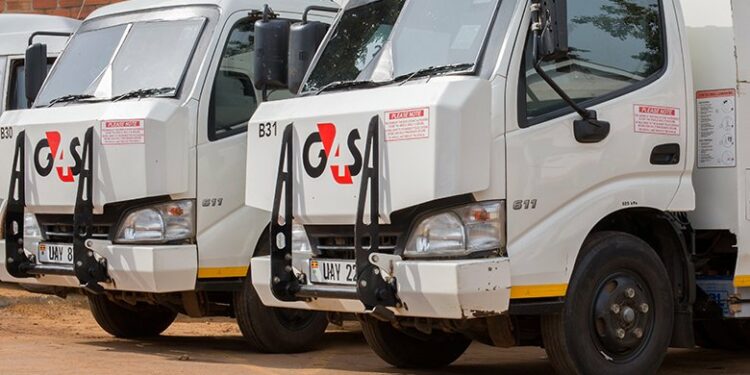Cash in transit commonly known as CIT is a service offered by major private security companies (PSOs) in Uganda. This service involves secuirty companies entering into commercial long or short agreements with either banks and other big trading companies that may need to move money from a point to point. CIT services are procured by consumers on a premise that it’s a safe way of moving money since its assumed that the van in use are specialized, the guards are armed and the vehicles are trucked from end to end.
The Police at Old Kampala Division are actively investigating circumstances under which two G4S security guards robbed over shs1b billion and 14,474USD from a bullion van during a cash transit operation in Kampala, Uganda’s capital.
The case, according to Kampala Metropolitan Police Deputy Spokesperson, ASP Luke Owoyesigyire, was reported on 19 November 2024 when the guards allegedly diverted a bullion van, registration number UAJ 199T, during a routine transfer of funds from Lubowa to Nakasero and robbed it clean.
“The stolen cash amounted to One Billion, Sixty-Nine Million, Four Hundred and Twenty Thousand Ugandan Shillings (UGX 1,069,420,000) and USD 14,474,” ASP Owoyesigyire said, adding that the vehicle was later found abandoned in Nabunya, Rubaga Division, along with two rifles left behind.
Owoyesigyire explained that police swiftly commenced investigations, leading to the arrest of a suspect, Otim Ambrose Richard, in Kwania District who was found in possession of UGX 117 million, believed to be part of the stolen funds.
Police assured the public that all efforts are being made to recover the remaining funds and bring the perpetrators to justice.
What should banks look out for before onboarding security companies for CIT services?
Banks should do due diligence on the prospective CIT service providers to confirm the following before awarding service contract.
Security apparatus on the CIT van,
The van should be bullet proof.
The trunk of the van should have a vault that is fire & bullet proof
The vault should have CCTV camera installed and linked with a control room
The vauls should be secured with one time codes as part of locking sytem. These codes are issued by a person in control room after confirming that the van has reached intended location.
Van should poses a GPS trucker that is also monitored by control room. The trucking device ensures that the bullion van is following the route chat/plan designed before the crew commander sets off from the base to the delivery or pick point. Any deviation from the route chat should be communicated to control room and seek permission. The deviation can be caused by various reasons like traffic jam, road closures, broken bridges, accidents etc.
The bullion van must at least have a crew commander-senior guard, driver, and guards who should never be less than 3.
The bullion van should be in a good mechanical conditions at all times.
The bullion van should be driven at maximum of 80kms per hour. This is to avoid accidents since it is a heavy vehicle due to heavy steel plates that forms party of the bulletproof body.
Bullion vans should be comprehensively insured not only against accidents but also the contents they carry.
Control room.
Control room is another important infrastructure in CIT business. It houses GPS trucking monitoring tools, CCTV screens, issues one time password for locking and opening of the vaults, monitors movement of the vans both physical and speed, if the van is moving, has stopped, is over speeding, instant breaking etc. the GPS system is a strong tool that it can even report the drivers behavior etc.
Radio contact with field team.
There should an hourly radio check with field teams. This is sometimes called SITREP-stituation report. SITREP is reaching out to the field team by either a controller or duty officer to confirm if all is well. This SITREP is critical because absence of response triggers QRF- Quick response teams to check on the physical site. For example if SITREP person is unable to reach to the intended contact, he/she will inform control room to either check GPS trucker to see the physical location of CIT van or make a cellphone call or check CCTV for visual confirmation.
Whereas there can be interference with radio communication, the GSM/GPRS system will be on and the controller should be able to reach out to the crew commander.
QRF/ERT-Teams.
Most private security companies have quick response teams-QRF or emergency response teams-ERT. These team are positioned in different areas especially in Kampala.
Operations office normally divides Kampala into operations areas like North, west, east, central CDB etc. in each operational zone, a central point is identified and it becomes a holding ground for QRF/ERT. This point is called standby location-standby Loc. If for example Mbuya, bugolobi, kinawataka, mutungo, industrial area, kireka falls under eastern zone, the standby loc can be plac
ed in Kinawataka. Any incident around these areas, the QRF will respond in less than 5 minutes. Quick response minimizes impact or frustrates bad intentions. The ERT teams must be armed, with mobile transport-vehicle/motorcycle, mantaians well charged radios/cellphones and must be more than two at all times.
Time delay locks.
Time delay locks are convenient for long routes like inter branches CIT services. A journey between Mubende branch and cash center in Kampala can be estimated to be at least 4 hours. The lock on the vault can be locked with a time delay lock. Time delay locks are timed during locking time and its set in a way that it cannot open until the set time lapses. For example, if the vault is closed at 14:00hrs (2pm), and set a time lock of 4 hours, it will accept unlocking commands after 18:00hrs (6pm). Before this time, it will not lock. Any tamper, will cause or activate loud noise, which can attract attention of the public.
Banks and other CIT user responsibility.
Security managers /risk officers of institutions that intend to use CIT services must carryout risk assessments and due diligence before contracting them. they must ensure that minimum security protocols are in place. Whereas all bank money is insured, such incidents are not good for the banks reputation. But also such incidents leads to increased insurance premiums. Some CIT companies have very old fleet with almost no enhanced security protocols on these ramshackled vans. Police- PSO department should keenly pick intrest in CIT facilities especially during annual audits. One of the mandates of private security department of police is to carryout annual audits. A committee is comprised of Police, ISO among other units that yearly conducted physical audits on PSOs to make sure that they comply with minimum standards prescribed in the regulations.
The G4S incident clearly shows that the major standards were either not in place or in the enforcement was not there.
Banks empower security managers to submit annual reports on the technical abilities of CIT companies. Those that found uncompliant should have the service agreements terminated. I have seen some bullion vans on the roads, they are DMCs.
Some secuirty companies are even responsible for the overall operations of ATMS that include putting money, reconciling journal rolls, etc. I remember not long ago, one of security companies robbed money of some ATMS through a well-syndicated fraud. By the time, the bank knew, it had lost good money in billions. Of course the security company paid back but this portrayed weak systems. ATMs are supposed to reconcile every day both in books, system and in physical cash like bank branches.
CIT is a necessity especially in cash economy like Uganda. CIT operations must be streamlined especially by use of both physical, electronic and mechanical security systems. No gaps should be left unclosed. Control room operatives remain the heart of CIT operations; they should be retooled to match the current needs of cash movements.
Samson Tinka
Security and Safety consultant.
tindsam@yahoo.com
Do you have a story in your community or an opinion to share with us: Email us at editorial@watchdoguganda.com













